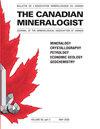Okieite, Mg3[V10O28]·28H2O,一种来自美国科罗拉多州San Miguel县Slick Rock矿区Burro矿的十氰酸盐新矿物
IF 1.5
4区 地球科学
Q3 MINERALOGY
引用次数: 3
摘要
Okieite,Mg3[V10O28]·28H2O,是来自美国科罗拉多州圣米格尔县Slick Rock区Burro矿的一种新的十钒酸盐矿物(类型地区);同样在科罗拉多州蒙特罗斯县Paradox Valley的Hummer矿也发现了这种矿物。这种矿物很稀有;它与dickthomssenite一起出现在含蒙脱石和硅灰石的砂岩上。Burro矿的奥灰岩晶体呈等角至棱柱状,通常呈弯曲柱状(长度约为3毫米),通常呈圆形。奥灰岩条纹为浅橙黄色,光泽为玻璃状。莫氏硬度约为1½,韧性为脆性,断裂为弯曲或贝壳状,没有解理,测量密度为2.20(2)g/cm3。Okieite为双轴(–),α=1.720(3),β=1.745(3)、γ=1.765(3)(白光);2V=84(2)°,具有较强的r<v色散。光学取向为X^a=37°,Y^c=28°,Z^b=31°。在奥灰岩中未观察到嗜铬细胞瘤。电子探针微量分析的经验公式(根据结构所示的V=10和O=56 apfu计算)为Mg2.86[HO.28V5+10O28]·28H2O。通过单晶X射线衍射法测定,Okieite为三斜晶系,具有10.55660(19)、b 10.7566(2)、c 21.3555(15)Å、α90.015(6)、β97.795(7)、γ104.337(7。粉末衍射图中最强的四条衍射线是[d inÅ(I)(hkl)]:9.71(100);8.32(19);11.04(17)(002);和6.42(12)(110,.奥赤铁矿的原子排列[R1=0.0352对于11327 I>2σI反射]由{V10O28}6–(十钒酸盐)结构单元和{[Mg(H2O)6]3·10H2O}6+间隙配合物。只有氢键将结构单元与间隙复合体的成分连接起来。Okieite与合成的Mg3[V10O28]·28H2O是同构的。okeite这个名字是科罗拉多州纳图里塔市的Craig(“Okie”)Howell的名字。本文章由计算机程序翻译,如有差异,请以英文原文为准。
Okieite, Mg3[V10O28]·28H2O, a new decavanadate mineral from the Burro mine, Slick Rock mining district, San Miguel County, Colorado, USA
Okieite, Mg3[V10O28]·28H2O, is a new decavanadate mineral from the Burro mine, Slick Rock district, San Miguel County, Colorado, USA (type locality); the mineral is also found at the Hummer mine, Paradox Valley, Montrose County, also in Colorado. The mineral is rare; it occurs with dickthomssenite on montroseite- and corvusite-bearing sandstone. Crystals of okieite from the Burro mine are equant to prismatic, commonly appearing like curving columns (up to about 3 mm in length) and often exhibiting rounded faces. The streak of okieite is light orange yellow, and the luster is vitreous. The Mohs hardness is ca. 1½, the tenacity is brittle, the fracture is curved or conchoidal, there is no cleavage, and the measured density is 2.20(2) g/cm3. Okieite is biaxial (–), with α = 1.720(3), β = 1.745(3), γ = 1.765(3) (white light); 2V = 84(2)° with strong r < v dispersion. The optical orientation is X ^ a = 37°, Y ^ c = 28°, Z ^ b = 31°. No pleochroism is observed in okieite. The empirical formula from electron-probe microanalysis (calculated on the basis of V = 10 and O = 56 apfu as indicated by the structure) is Mg2.86[H0.28V5+10O28]·28H2O. Okieite is triclinic, , with a 10.55660(19), b 10.7566(2), c 21.3555(15)Å, α 90.015(6), β 97.795(7), γ 104.337(7)°, and V 2326.30(19)Å3, as determined by single-crystal X-ray diffractometry. The strongest four diffraction lines in the powder diffractograms are [d in Å(I)(hkl)]: 9.71(100); 8.32(19); 11.04(17)(002); and 6.42(12)(110, . The atomic arrangement of okieite [R1 = 0.0352 for 11,327 I > 2σI reflections] consists of a {V10O28}6– (decavanadate) structural unit and a {[Mg(H2O)6]3·10H2O}6+ interstitial complex. Only hydrogen bonding links the structural unit with the components of the interstitial complex. Okieite is isostructural with synthetic Mg3[V10O28]·28H2O. The name okieite is for Craig (“Okie”) Howell of Naturita, Colorado.
求助全文
通过发布文献求助,成功后即可免费获取论文全文。
去求助
来源期刊

Canadian Mineralogist
地学-矿物学
CiteScore
2.20
自引率
22.20%
发文量
45
审稿时长
4-8 weeks
期刊介绍:
Since 1962, The Canadian Mineralogist has published papers dealing with all aspects of mineralogy, crystallography, petrology, economic geology, geochemistry, and applied mineralogy.
 求助内容:
求助内容: 应助结果提醒方式:
应助结果提醒方式:


